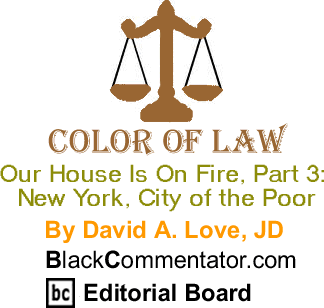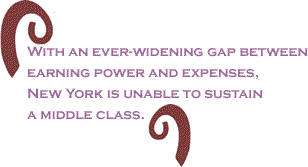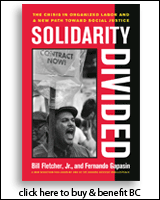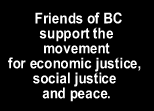
|
|||||||||||||||||||||||

|
|

Custom Search
|
|
 |
|
Click here to read any of the commentaries in this series. As the song goes, ďIf I can make it there, Iíll make it anywhere, itís up to you, New York, New York.Ē The problem is that if you are counting on making it in New York City, you could be setting yourself up for disappointment. A recent report by The Center for an Urban Future, a public policy organization dedicated to dealing with the problems facing low-income and working-class neighborhoods in New York City, suggests that the Big Apple is too expensive for most people to live. The report, called Reviving the City of Aspiration: A study of the challenges facing new York Cityís middle class, confirms what many New Yorkers already knew anecdotally - with an ever-widening gap between earning power and expenses, New York is unable to sustain a middle class. In a city where even many upper middle class families are stretched to their limits, the cost of living is beyond the reach of most working families. The city lost more than its fair share of blue collar manufacturing jobs over the years. There are no new jobs to create or sustain a middle-class lifestyle, and there is little hope of upward mobility. New York City never was cheap, but it was once perceived as a city of aspiration, a place where people could live, work, scratch their way up the ladder, and raise a family. But people are leaving, and the path from poverty to the middle class is proving far more elusive. These days, the city is losing a number of demographic groups, including people with a bachelorís degree, families, immigrants, municipal workers, and the Black community of Eastern Queens, one of the countryís largest African American middle class populations. Meanwhile, the ranks of the poor are rising. In 2005, 46% of new Yorkers living in poverty held regular jobs, a 17 point increase from 1990. And 31% of New Yorkers over age 18 work in low wage jobs. There are a number of challenges facing working families. First and foremost, of course, is the high cost of living, particularly exorbitant housing costs. In addition, the price New Yorkers pay for electricity, phone service, auto insurance, parking, milk, home heating oil and state and local taxes are among the highest in the nation. While most families require two working parents to make ends meet, child care is prohibitively expensive, averaging $13,000 to $25,000 per year, per child. Then there are the inferior quality schools and the long, uncomfortable commutes on public transportation for people who live outside Manhattan, in one of the outer boroughs. And there was the housing boom which led to haphazard construction, diminishing the aesthetic qualities of many New York City neighborhoods, and straining the infrastructure of many communities.
As for those who are leaving New York, where are they going? Well, it should be no surprise that they are moving to places such as Philadelphia. Iím not surprised because I am a New Yorker who moved to Philadelphia. I was born and raised in New York, and although I had lived in a number of places - as diverse as Boston, Detroit and Tokyo - I was a New Yorker. You can never really get the New York out of your system, even if you try, and you probably wouldnít want to do it in any case. A New York community activist and journalist, I came to Philly for law school, where I met my wife, a Philadelphian turned New York activist. We had grand ideas of moving to Brooklyn after law school. But we were pulled back to Philadelphia, in no small measure, because we had expensive college and law school education, but with public interest careers with modest salaries serving underserved communities. You do the math. And besides, Philadelphia is a great city with a distinctive, down-to-earth character, a thriving arts community and public parks, and a sizable progressive community, albeit with its problems and challenges like any other city.
Meanwhile, New York, the capital of American capitalism and global capitalism, has become a city that only AIG executives, hedge fund managers, art dealers, and hotshot corporate lawyers can afford. The rest are poor, strangled and struggling. This is a scenario that would make Dickens blush. Yet, this was in the works for years before the economic crisis, in a city and a nation that has witnessed the dramatically widening gap between rich and poor, via public policy. And how telling that the titans of capitalism - who have brought down Wall Street through their own unchecked greed, and have no qualms about taking their corporate stimulus welfare payments - are now fighting vigorously to kill the Employee Free Choice Act and other initiatives that would help average working New Yorkers earn a living and raise their families. As the report notes, there are a number of things that should be done to save New York: better-paying jobs, upgrades to infrastructure, diversifying the economy to include green jobs, and utilizing community college as a path to upward mobility. And there is the need to move away from the construction of luxury developments and sports stadiums, towards building affordable homes for everyday families, people with middle incomes, and professionals. In the end, New York City provides a reality-based cautionary tale about the future of America, mired in poverty, about its priorities, what it has become and what it can become. This city that never sleeps, and other cities as well, will experience economic and social death without a vibrant middle class and viable opportunities to earn a living. Click here to read any of the commentaries in this series. BlackCommentator.com Editorial Board member David A. Love, JD is a lawyer and journalist based in Philadelphia, and a contributor to the Progressive Media Project, McClatchy-Tribune News Service, In These Times and Philadelphia Independent Media Center. He contributed to the book, States of Confinement: Policing, Detention, and Prisons (St. Martin's Press, 2000). Love is a former Amnesty International UK spokesperson, organized the first national police brutality conference as a staff member with the Center for Constitutional Rights, and served as a law clerk to two Black federal judges. His blog is davidalove.com. Click here to contact Mr. Love. |
|
Any BlackCommentator.com article may be re-printed so long as it is re-printed in its entirety and full credit given to the author and www.BlackCommentator.com. If the re-print is on the Internet we additionally request a link back to the original piece on our Website. Your comments are always welcome. eMail re-print notice
If you send us an eMail message we may publish all or part of it, unless you tell us it is not for publication. You may also request that we withhold your name. Thank you very much for your readership. |
|
| |
|
| March
26 , 2009 Issue 317 |
|
| Executive Editor: Bill Fletcher, Jr. |
| Managing Editor: Nancy Littlefield |
| Publisher: Peter Gamble |
| Est. April 5, 2002 |
Printer Friendly Version
in resizeable plain
text format or pdf
format. |
| Frequently Asked Questions |
 |

|
 |
 |
 |
| |
| |




































